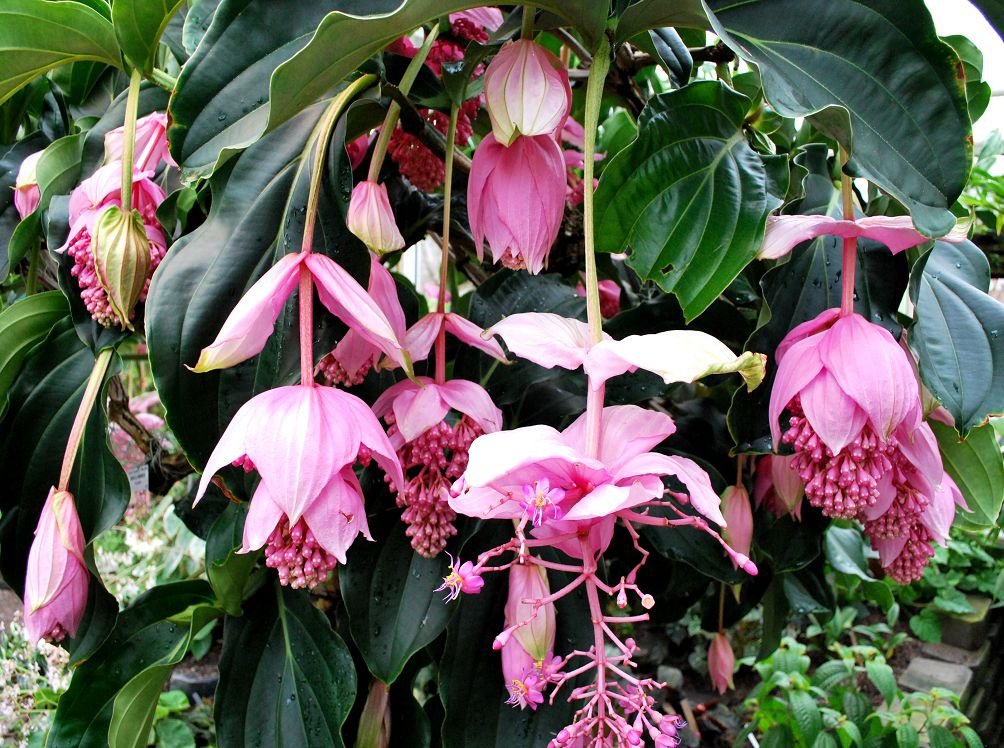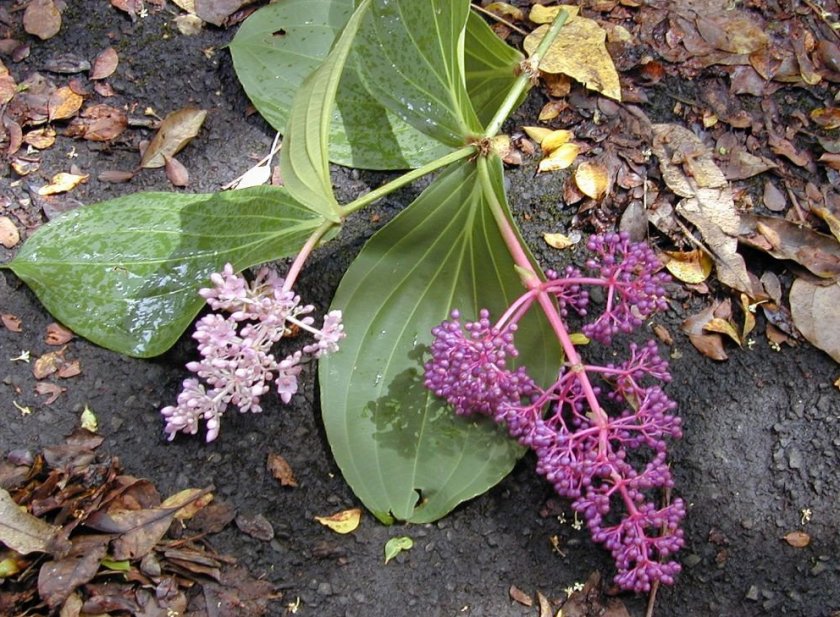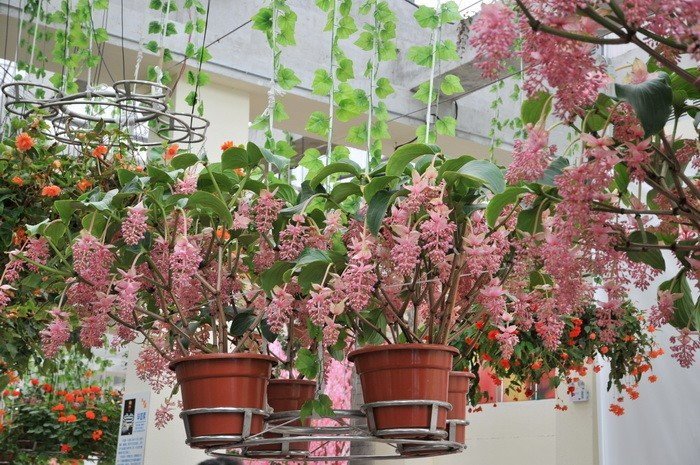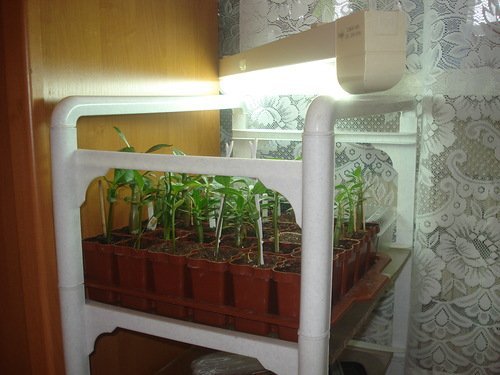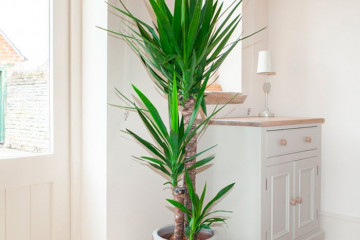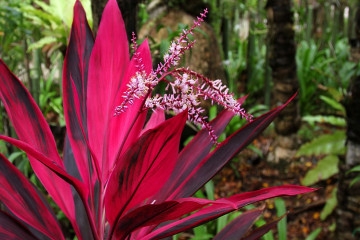Medinilla flower: home care and propagation methods
Content:
The amazing medinilla flower is very rarely found in nature. The habitats include the rainforests of the Philippines, as well as the island of Java in Madagascar. Medinilla is a precious flower in the literal sense of the word. Several branches with flowers of a beautiful shrub are estimated at $ 500-700.
Origin
In the natural conditions of tropical Africa, Asia and the Pacific Islands, there are about 300 species of the genus Medinilla. She is a member of the Melastomov family. Some representatives of medinilla look like a long liana, reaching a length of three meters, but most of them grow in the form of a herbaceous bush. Sometimes medinilla can be found in the form of a small tree.
At home, medinilla has spread like a bush. Its height differs from natural dimensions. The potted plant has a height of 70 cm to 1.2 meters.
Main types
Florists grow a limited number of species. The most famous are the following.
Medinilla Magnifica
It is also called the magnificent medinilla. It is considered the most common type in home floriculture. Her homeland is the Philippine Islands. Breeders, taking as a basis medinilla Magnifica, received varieties such as:
- Dolce Vita - has massive clusters of pink inflorescences.
- Bello - is a miniature variety of medinilla. It has a short flower brush.
- Jadore Tresor is a representative of a low-growing variety. It has white-purple or unusual bluish flowers.
Medinilla veiny
Veinous melastoma is the second name of medinilla. Her homeland is Malaysia. The plant has aerial roots that descend to the ground. Therefore, the vein medinilla is considered a semi-epiphyte.
The leaves of this type of medinilla are small, with a bristly surface and a sharp end. The inflorescences are flesh-colored and have the appearance of an umbrella.
Medinilla Cuming
The homeland of this type of medinilla is the Philippines. This is a semi-epiphyte. The leaves are shiny, with a slight concavity.
Inflorescences of medinilla have the form of brushes with pink flowers, resembling lilacs.
Medinilla Javanese
One of the popular types of medinilla common in indoor floriculture is Javanese. The flower is unpretentious to care for, it looks like a small shrub up to 1 meter high. Javanese blooms with small lilac-purple flowers on the brushes. It does not differ in particular decorativeness due to the fact that it does not have bracts.
When purchasing medinilla in a flower shop, you need to carefully examine it. If a dark spot is found on the stems, this indicates a sign of plant disease. Experienced growers who breed Medinilla varieties do not recommend buying discounted plants. If the plant is discounted, then something is wrong with its health. In this case, money will be spent, there will be no pleasure from the purchase.
Caring for medinilla at home
To see the beauty of flowering medinilla, flower growers create not just good, but ideal conditions for this. What does home care for Magnifica medinilla consist of?
For the plant, you need to create the most approximate conditions of the tropics - a humid and warm atmosphere. Those florists who have a winter garden or greenhouse in the house can create such conditions.
Lighting
In spring and summer, medinilla loves bright, but diffused light. The best places to put flower pots are in the sills of windows facing south, east, or west. Flower pots should not be close to the window glass, so as not to burn the leaves through it from the midday sun. It is advisable not to move the pot - the flower does not like it. During the bright sun, you need to shade the windows.
In the autumn-winter period, organize a daylight hours for a flower at least 12 hours. For this, artificial illumination is carried out. When creating such a light regime, the buds are set for spring flowering.
Temperature
The temperature regime is also maintained depending on the season. The optimum temperature during the spring-summer period is from +20 to 25 ° С. The flower will feel great in a glazed balcony.
In the autumn-winter period, a moderate temperature of + 17-18 ° C is suitable for the flower. Doesn't like a tropical plant to be near heating devices and near cold glass.
Air humidity
It is necessary to provide high air humidity of 70-80% year-round. In winter, when the heating system is on, the flower must be sprayed 2 times a day. Drops should not fall on the buds. You can humidify the air in various ways: put a tray with water or use a double pot, filling the space between the walls with moss, constantly moistening it.
Watering
For the plant, watering is extremely important throughout the growing season. Neither waterlogging nor drying out of the soil should be allowed. Water only when the top layer dries out. Water quality plays an important role in plant nutrition. Water for irrigation should be at room temperature, separated.
In the spring and summer, the flower is watered abundantly. In winter, watering is carried out once every two weeks. Moisture retention in the pot is ensured by mulching.
The soil
For medinilla, the soil must be correctly selected, since it is the medium from which the roots receive nutrition and moisture. The flower prefers a loose substrate or ready-made soil for epiphytic plants.
Top dressing
To maintain the decorative effect of the plant, it needs feeding. For this, liquid mineral fertilizer is applied to the soil once every two weeks, starting from the end of March and until the beginning of August. In winter, medinilla is not fed.
Plant transplant
Florists who breed medinilla advise replanting this tropical plant annually. It is noted that after transplantation, it develops faster. The upper part of the flower is large due to the leaves and flower brushes, the root system is adapted to penetrate only into the upper layer of the soil, so it makes no sense to choose a deep pot. For medinilla, wide containers are suitable, where the roots of a flower can be spread almost near the surface.
It is necessary to put a drainage layer on the bottom of the pot, pour soil on top, and if a plant is transplanted, the flower extracted with a lump of earth is moved to a new pot.First, you need to inspect the roots, if necessary, shorten them a little. Fill up with new soil, compacting it so that there are no voids. After planting, water the plant, spray and place the pot in a permanent place.
Pruning
The best time to prune is when transferring the plant to a new pot. This is usually done after flowering. Pruning is needed to give the bush a neat look. Elongated branches, dry inflorescences are cut off, and shoots are also shortened.
Reproduction methods
Experienced growers note that the medinilla flower does not lend itself very well to reproduction at home. However, it can still be grown from seeds and woody cuttings.
Sowing seeds
It is more difficult to grow medinilla from seeds than by cuttings. The seeds of this plant are expensive and sometimes difficult to even find. If, nevertheless, a decision is made to grow medinilla from seeds, they need to be sown at the end of winter in a greenhouse with moistened soil. Seeds are not embedded in the soil. The temperature at which the seeds will sprout is + 25-30 ° С. High humidity must be created.
Seedlings are planted in separate pots, and they continue to be in the greenhouse. For grown seedlings, you need to pinch off the tops for branching.
Cuttings
Reproduction by cuttings is combined with the spring pruning of the plant. Cut semi-lignified shoots with three buds are placed for several minutes in a solution with phytohormone to accelerate root formation. Next, the cuttings are placed in a greenhouse with wet sand. Rooting occurs only at a temperature of + 28-30 ° C within a month. Young plants are then placed in a nutrient soil in a permanent place.
Florists note that if you take good care of a plant, it will bring pleasure every year with its flowering.

